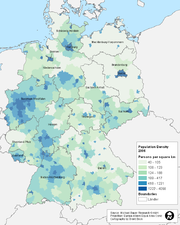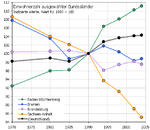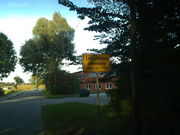Demographics of Germany
The Demographics of Germany were determined also by a series of full Census in Germany, with the most recent held in 1987. Since reunification, German authorities rely on a micro census.
This article is about the demographic features of the population of Germany, including population density, ethnicity, education level, health of the populace, economic status, religious affiliations and other aspects of the population.


The demography of the Federal Republic of Germany is monitored by the "Statistisches Bundesamt" (Federal Statistical Office of Germany). The population of Germany is approximately 81,880,000, making it the 14th most populous country in the world. Germany's population is characterized by zero or declining growth,[1] with an aging population and smaller cohort of youths.
More than 16 million people are of non-German descent (first and second generation, including mixed heritage), about seven million of which are foreign residents. The largest ethnic group of non-German origin are the Turkish. Since the 1960s, West and later reunified Germany has been attracting migrants primarily from Southern and Eastern Europe as well as Turkey, many of which (or their children) over time acquired German citizenship. While most of these migrations had an economic background, Germany has also been a prime destination for refugees from many developing countries, in part because its constitution long had a clause giving a 'right' to political asylum, but restrictions over the years have since made it less attractive.
Within Germany, there is a long history of East-to-West migrations, starting with the 19th century Ostflucht. After the World War II border shifts and expulsions, the Germans from Eastern Europe and the former eastern territories moved westward to post-war Germany. During the partition of Germany, many Germans from East Germany fled to West Germany for political and also economic reasons. Since Germany's reunification, there are ongoing migrations from the eastern New Länder to the western Old Länder for economic reasons.
Germany has one of the world's highest levels of education, technological development, and economic productivity. Since the end of World War II, the number of students entering universities has more than tripled, and the trade and technical schools are among the world's best. With a per capita income of about $27,000, Germany is a broadly middle class society. Germans also are very mobile; millions travel abroad each year. The social welfare system provides for universal health care, unemployment compensation, and other social programmes. Due to Germany's aging population and struggling economy, the welfare system came under a lot of strain in the 1990s. This led the government to push through a wide-ranging programme of belt-tightening reforms, Agenda 2010, including the labour market reforms known as Hartz I - IV.
Contents |
Major metropolitan regions
Germany officially has eleven metropolitan regions. In 2005 Germany had 82 cities with more than 100,000 inhabitants.
| City name | Location | Description | Population (2004) | Largest German ethnic groups | Largest non-German ethnic groups |
|---|---|---|---|---|---|
| Rhine-Ruhr Metropolitan Region |  |
Cologne is the largest city of the Rhineland, the very Western part of Germany. Particularly among young Germans, Cologne and Düsseldorf are known for their nightlife and open-minded atmosphere. | 11.6 million | Rhinelanders, Westfalians and others | Turks, Poles, Italians, Dutch, French, Arabs, Iranians, South Asians like Indians, and Japanese (large Japanese community in Düsseldorf). |
| Frankfurt Rhine-Main Region |  |
Frankfurt is the economic and financial center both for Germany and the continental European Union. Frankfurt is arguably Germany's most international city. It boasts a large airport and numerous skyscrapers. Within Germany, the city has a reputation of being very business-oriented, perhaps at the expense of other pursuits. | 5.8 million | Hessians and others | Turks, Italians, Dutch, Arabs, Iranians, Greeks, Russians, Poles, Israelis, Koreans, Afghans, and Pakistanis (mostly Pashtun & Panjabi ethnic groups). |
| Munich Metropolitan Region |  |
Munich has Germany's highest standard of living. Countless sporting and leisure opportunities - both in the city and in its picturesque region. Munich is a powerhouse of the German economy and rich in Bavarian culture. | 4.7 million | Bavarians, Franconians and others | Turks, Croats, Serbs, Dutch, Afghans, Greeks, Albanians, Macedonians, Italians, Bosnians, Hungarians, Spaniards and Romanians. |
| Berlin/Brandenburg Metropolitan Region |  |
Berlin is the capital of Germany and its largest city. Berlin lies in the eastern part of the country and is regarded as one of Europe's most vibrant and ever changing capitals. But the city still has a high unemployment rate. | 4.3 million | Berliners, Brandenburgians and others | Turks, Arabs, Poles, Russians, Albanians, Serbs, Macedonians, Vietnamese, Dutch, Chinese, rising number of Africans, Chileans and other Latin Americans. |
| Hamburg Metropolitan Region |  |
Hamburg is a free city state and the second largest city in Germany. It has a long tradition for sea trade and civil establishment and is home to Europe's 2nd largest port. The city is proud of its diverse nightlife and music scene centered in and around the famous St. Pauli district. According to European Union Statistics (EUROSTAT) it is Germany's richest city. | 4.3 million | Hamburgers, Schleswiger, Holsteiner, Lower Saxons and others | Turks, Russians, Albanians, Dutch, Poles, Pakistanis, Iranians, Macedonians, Chinese, Portuguese, Afghans, Africans |
| Leipzig-Halle-Dresden (Saxon Triangle) |  |
Also dubbed "City of Heroes", Leipzig is where the 1989 revolution that brought down the Berlin Wall started. Today totally refurbished, it sports Europe's highest density of Art Nouveau architecture. Very lively bar scene, fastest growing economy in Germany. | 3.5 million | Saxons and others | Vietnamese, Poles, Russians, Portuguese, Italians, Iranians, Turks, Dutch, Arabs, Indians and Pakistanis. |
| Stuttgart Metropolitan Region |  |
Stuttgart has a reputation for research, inventions and industry. The German headquarters of many international enterprises are in Stuttgart. This contrasts with the strong rural, down-to-earth attitude of the Stuttgarters throughout the classes. A popular slogan is "We are good at everything. Except speaking High (standard) German." | 3.5 million | Swabians and others | Turks, Greeks, Dutch, Italians, Croats, Serbs, French, Chinese, Romanians, Americans and Spaniards. |
| Bremen/Oldenburg Metropolitan Region |  |
Located in the northwestern part of Germany, the main axis contains the cities of Bremen, Delmenhorst and Oldenburg, with the cities of Wilhelmshaven and Bremerhaven being the northern corners at the north sea. Major rural areas are covered in between these cities. There is a smooth transition to the Hamburg metropolitan area to the east. | 2.4 million | Lower Saxons, Frisians and others | Turks, Russians, Poles, Albanians, Serbs, Portuguese, Iranians, Dutch, Americans and Britons. |
Ethnic groups



In 2005: Total population = 82 million[2]
In 2008 18.4% of Germans of any age group and 30% of German children had at least one parent born abroad. Median age for Germans with at least one parent born abroad was 33.8 years, while that for Germans, who had two parents born in Germany was 44.6 years.[4]
Four other sizable groups of people are referred to as "national minorities" (nationale Minderheiten) because they have lived in their respective regions for centuries: Danes, Frisians, Roma and Sinti, and Sorbs. There is a Danish minority (about 50,000, according to government sources) in the northern-most state of Schleswig-Holstein. Eastern and Northern Frisians live at Schleswig-Holstein's western coast, and in the north-western part of Lower Saxony. They are part of a wider community (Frisia) stretching from Germany to the northern Netherlands. The Sorbs, a Slavic people with about 60,000 members (according to government sources), are in the Lusatia region of Saxony and Brandenburg. They are the last remnants of the Slavs that lived in central and eastern Germany since the 7th century.
Roma people have been in Germany since the Middle Ages. They were persecuted by the Nazis, and thousands of Roma living in Germany were killed by the Nazi regime. Nowadays, they are spread all over Germany, mostly living in major cities. It is difficult to estimate their exact number, as the German government normally does not keep information on the ethnicity of its citizens. There are also many assimilated Sinti and Roma. A vague figure given by the German Department of the Interior is about 70,000. In the 1990s, many Roma moved to Germany from former Yugoslavia. In contrast to the old-established Roma population, the majority of them do not have German citizenship, they are classified as immigrants or refugees.
After World War II, 14 million ethnic Germans were expelled from the eastern territories of Germany and homelands outside former German Empire. The accommodation and integration of these Heimatvertriebene in the remaining part of Germany, in which many cities and millions of apartments had been destroyed, was a major effort in the post-war occupation zones and later states of Germany.
Since the 1960s, ethnic Germans from the People's Republic of Poland and Soviet Union (especially from Kazakhstan, Russia, and Ukraine), have come to Germany. During the time of Perestroika, and after the dissolution of the Soviet Union, the number of immigrants increased heavily. Some of these immigrants are of mixed ancestry. During the 10 year period between 1987 and 2001, a total of 1,981,732 ethnic Germans from the FSU immigrated to Germany, along with more than a million of their non-German relatives. After 1997, however Ethnic Slavs or those belonging to Slavic-Germanic mixed origins outnumbered pure blooded Germans amongst the immigrants. The total number of people currently living in Germany having FSU connection is around 4 to 4.5 million (Including Germans, Slavs, Jews and those of mixed origins), out of that more than 50% is pure-blooded German.[5][6]
Germany now has Europe's third-largest Jewish population. In 2004, twice as many Jews from former Soviet republics settled in Germany as in Israel, bringing the total inflow to more than 200,000 since 1991. Jews have a voice in German public life through the Zentralrat der Juden in Deutschland. Some Jews from the former Soviet Union are of mixed heritage.
In the year 2000 there were also around 300,000 Afro-Germans[7] and 150,000+ African nationals. Numerous persons from Tunisia and Morocco live in Germany, which in most cases do not considers themselve "Afro-Germans" and are not considered "Afro-Germans" by the German public despite the fact they come from Northern Africa, because they look different and have a different culture. Nearly 50,000 Indian-Germans live in Germany.
Germany's biggest East Asian minority are the Vietnamese people in Germany.
Numerous descedants of the so called Gastarbeiter live in Germany. The Gastarbeiter mostly came from Italy, Greece, Turkey, Morocco, Portugal, Tunisia, Yugoslavia, Vietnam, North Korea, Angola, Mozambique and Cuba.
In German statistics a person, who has at least one parent born abroad will be counted as a person with immigrant background. That is also the case if the other parent is German and the person himself or herself has been born in Germany and holds the German citizenship.[8] If a person born in Germany holding the German citizenship, for example, has one German and one Korean parent, he or she will be counted "German with Korean immigrant background", "German with (East-)Asian immigrant background" or "Eurasian". Another category used is "East Asian including Eurasian". Other categories that would make much sense such as "ethnic German including Eurasian" or "European including Eurasian" are not used. This way of counting of course inflates the number of persons who are counted as "person with immigrant background" or "of non European heritage".
New federal states

About 1.7 million people have left the new federal states since the fall of the Berlin Wall, or 12% of the population,[9] a disproportionately high number of them were women under 35.[10]
After 1990, the fertility rate in the East dropped to 0.77. In 2006, the rates in the new states (1.30) are approaching those in the West (1.37).[11] Since 1989, about 2,000 schools have closed because of a scarcity of children.[9]
In some regions the number of women between the ages of 20 and 30 has dropped by more than 30 percent.[9] In 2004, in the age group 18-29 (statistically important for starting families) there were only 90 women for every 100 men in the new federal states (including Berlin).[11]
Immigration

In its State of World Population 2006 report, the United Nations Population Fund lists Germany with hosting the third-highest percentage of the main international migrants worldwide, about 5% or 10 million of all 191 million migrants.[12]
Agreements
Germany had previously signed special visa agreements with several countries in times of severe labour shortages or when particular skills were deficient within the country. During the 60s & 70s, agreements were signed with the governments of Turkey, Yugoslavia and Spain to help Germany overcome its severe labour shortage. More recently, the German government has signed an agreement with Pakistan, to allow many Pakistani skilled professionals, IT personnel and engineers incentives to come to Germany.
Religions
Roman Catholic 31.4%, Evangelical Church in Germany 30.8%, Nonreligious 29.6%, Muslim 4%, Orthodox 2%[13] Roman Catholic is mainly in the South East (Southern Bavaria) and the Far West (Rheinland & Cologne). Strongholds of Protestants are in all Northern States. Muslim, Orthodox and Jewish minority communities are mainly in the big cities.
Languages
German is the only official and most-widely spoken language. Standard German is understood throughout the country.
Minority languages
Danish, Low German, the Sorbian languages (Lower Sorbian and Upper Sorbian), and the two Frisian languages, Saterfrisian and North Frisian, are officially recognized and protected as minority languages by the European Charter for Regional or Minority Languages in their respective regions. With speakers of Romany are living in all parts of Germany, the federal government has promised to take action to protect the language. Until now, only Hesse has followed Berlin's announcement, and agreed on implementing concrete measures to support Romany speakers.
Implementation of the Charter is poor. The monitoring reports on charter implementation in Germany show many provisions unfulfilled.[14]
Minority language recognition
| Language | States |
|---|---|
| Danish | Schleswig-Holstein |
| North Frisian | Schleswig-Holstein |
| Saterland Frisian | Lower Saxony |
| Low German | Brandenburg, Bremen, Hamburg, Mecklenburg-Vorpommern, Lower Saxony, Saxony-Anhalt, Schleswig-Holstein, North Rhine-Westphalia |
| Upper Sorbian | Saxony |
| Lower Sorbian | Brandenburg |
| Romany | Hesse (see text) |
Dialects

German dialects — some quite distinct from the standard language — are used in everyday speech, especially in rural regions. Many dialects, for example the Upper German varieties, are to some degree cultivated as symbols of regional identity and have their own literature, theaters and some few TV programming. While someone speaking dialect outside his home area might be frowned upon, in their original area some dialects can be spoken throughout all social classes. Nevertheless, partly due to Standard German media prevalence, their use has declined over the past century, especially in the younger population.
The status of different German dialects can be very different. The Alemannic and Bavarian dialects of the south are positively valued by the speakers and can be used in almost all social circumstances. The Saxonian and Thuringian dialects have less prestige and are subject to derision. While Bavarian and Alemannic have kept much of their distinctiveness, the Middle German dialects, which are closer to Standard German, lost some of their distinctive lexical and grammatical features and tend to be only pronunciation variants of Standard German.
Low Saxon dialects
Low Saxon is officially recognized as a language on its own, but despite this fact, there's little official action taken on fostering the language. Historically one third of Germany's territory and population was Low Saxon speaking. No data was ever collected on the actual number of speakers, but today the number of speakers ranges around 5 million persons. Despite this relatively high number of speakers there is very few coverage in the media (mostly on NDR TV, no regular programming) and very few education in or on the language. The language is not fixed as part of the school curriculum and Low Saxon is used as a medium of instruction in one school only in the whole Germany (as a "model project" in primary school sided by education in Standard German). As a consequence the younger generation refused to adopt the native language of their parents. Language prevalence dropped from more than 90% (depending on the exact region) in the 1930s to less than 5% today. This accounts for a massive intergenerational gap in language use. Older people regularly use the language and take private initiative to maintain the language, but the lack of innovative potential of the younger generation hinders language maintenance. The language too has an own literature (around 150 published books every year) and there are many theatres (mostly lay stages, but some professional ones, like for example Ohnsorg-Theater).
Use of Low Saxon is mainly restricted to use under acquaintances, like family members, neighbours and friends. A meeting of a village council can be held almost completely in Low Saxon if all participants know each other (as long as written protocols are written in Standard German), but a single foreigner can make the whole switching to Standard German.
The Low Saxon dialects are different in their status too. There's a north-south gradient in language maintenance. The Southern dialects of Westfalian, Eastfalian and Brandenburgish have had much stronger speaker losses, than the northern coastal dialects of Northern Low Saxon. While Eastfalian has lost speakers to Standard German, Westfalian has lost speakers to Standard German and Standard German based regiolect of the Rhine-Ruhr area. Brandenburgish speakers mostly switched to the Standard German based regiolect of Berlin. Brandenburgish is almost completely replaced by the Berlin regiolect. Northern Low Saxon speakers switched mostly to pure Standard German.
Foreign languages
English is the most common foreign language and almost universally taught by the secondary level. Other languages taught are French, Italian, Spanish, Portuguese, and Russian. Dutch is taught in states bordering the Netherlands and Polish in the case of the eastern states facing Poland. Latin and Ancient Greek are part of the classical education syllabus offered in many secondary schools.
According to a 2004 survey, two-thirds of Germany's citizens have at least basic knowledge of English. About 20% consider themselves to be speakers of French, followed by speakers of Russian (7%), Italian (6.1%), and Spanish (5.6%). The relatively high number of Russian speakers is a result of massive immigration from the former Soviet Union to Germany for almost 10 consecutive years — more than half of the Germans in the East learned Russian at school.
Literacy
Over 99% of those of age 15 and above are estimated to be able to read and write. However a growing number of inhabitants are functionally illiterate. The young are much more likely to be functionally illiterate than the old. According to a study done by the "University of Bremen" in coorporation with the "Bundesverband Alphabetisierung e.V.", ten percent of youngsters living in Germany are illiterate and one quarter was able to understand only basic level texts.[15] Illiteracy rates of youngsters vary by ethnic group and parents socioeconomic class.
Demographic statistics and policies

The following demographic statistics are from the CIA World Factbook, unless otherwise indicated.
- Population
82,329,758 (July 2009 est.)
- Age structure
- 0–14 years: 13.9% (male 5,894,724/female 5,590,373)
- 15–64 years: 66.3% (male 27,811,357/female 26,790,222)
- 65 years and over: 19.8% (male 6,771,972/female 9,542,348) (2007 est.)
- 0–14 years: 13.7% (male 5,768,366/female 5,470,516)
- 15–64 years: 66.1% (male 27,707,761/female 26,676,759)
- 65 years and over: 20.3% (male 7,004,805/female 9,701,551) (2009 est.)
- Population growth rate
-0.12% (2007 est.)
-0.053% (2009 est.)
- Birth rate
8.3 births/1,000 population (2008 est.)
8.18 births/1,000 population (2009 est.)
- Death rate
10.3 deaths/1,000 population (2008 est.)
10.9 deaths/1,000 population (July 2009 est.)
- Net migration rate
0.49 migrant(s)/1,000 population (2007 est.)
2.19 migrant(s)/1,000 population (2009 est.)
- Sex ratio
- at birth: 1.06 male(s)/female
- under 15 years: 1.05 male(s)/female
- 15–64 years: 1.04 male(s)/female
- 65 years and over: 0.72 male(s)/female
- total population: 0.97 male(s)/female (2009 est.)
- Infant mortality rate
4.09 deaths per 1,000 live births (2007)
total: 3.99 deaths/1,000 live births (2009)
- Life expectancy at birth
total population: 79.26 years (2009)
- Total fertility rate
1.38 children born/woman (2008)
1.41 children born/woman (2009 est.)
In 1996, TFR was 1.39 for ethnic Germans and 2.40 (down from 4.4 births per woman in 1970 [16]) for ethnic Turks.[17]
The Mikrozensus done in 2008 revealed that the number of children a German women aged 40 to 75 had, was closely linked to her educational achievement.[18] In Western Germany the most educated women were the most likely to be childless. 26% of those groups stated they were childless, while only 16% of those having an intermediate education, and 11% of those having compulsory education stated the same. In Eastern Germany however, only 9% of the most educated women of that age group and only 7% of those who had a intermediary education were childless, while 12% of those having only compulsory education were childless. The reason for that east-western difference is the fact that the GDR had an "educated mother scheme" and actively tried to encourage first births among the more educated. It did so by propagandizing the opinion that every educated woman should "present at least one child to socialism" and also by financially rewarding its more educated citizen to become parents. The government especially tried to persuade students to become parents while still in college and it was quite successful in doing so. In 1986 38% of all women, who were about to graduate from college, were mothers of at least one child and additional 14% were pregnant and 43% of all men, who were about to graduate from college, were fathers of at least one child. There was a sharp decline in the birth rate and especially in the birth rate of the educated after the fall of the Berlin wall. Nowadays only 5% of those about to graduate from college are parents.
The more educated a Western German mother aged 40 to 75 is, the less likely she is to have a big family.
| Percent of Western German mothers having 1, 2 and 3 and more children by educational attainment | ||||
|---|---|---|---|---|
| number of children | compulsory education | intermediary education | highest education | |
| one child | 22 | 30 | 31 | |
| two children | 39 | 48 | 48 | |
| three or more children | 39 | 22 | 21 | |
| [19] | ||||
The same is true for a mother living in Eastern Germany.
| Percent of Eastern German mothers having 1, 2 and 3 and more children by educational attainment | ||||
|---|---|---|---|---|
| number of children | compulsory education | intermediary education | highest education | |
| one child | 23 | 33 | 33 | |
| two children | 37 | 46 | 51 | |
| three or more children | 40 | 21 | 16 | |
| [19] | ||||
References
- ↑ "Population Handbook, 5th edition". Population Reference Bureau. http://www.prb.org/pdf/PopHandbook_Eng.pdf.
- ↑ 2.0 2.1 2.2 2.3 2.4 2.5 2.6 Germans and foreigners with an immigrant background by Federal Ministry of the Interior [1]
- ↑ http://www.serbien-montenegro.de/html/serbien_-_serben_in_deutschlan.html
- ↑ Statistisches Bundesamt Deutschland: "Leichter Anstieg der Bevölkerung mit Migrationshintergrund". Pressemitteilung Nr.105 vom 11.03.2008
- ↑ http://www.iza.org/iza/en/papers/transatlantic/1_locher.pdf
- ↑ http://www.odessa3.org/journal/pohl.pdf
- ↑ Nina Zimnik: Nicht jeder Deutsche ist automatisch weiß „Hamburger Abendblatt“ vom 15. August 2000
- ↑ Statistisches Bundesamt Deutschland: Bevölkerung und Erwerbstätigkeit. Bevölkerung mit Migrationshintergrund – Ergebnisse des Mikrozensus 2005. Erschienen am 4. Mai 2007
- ↑ 9.0 9.1 9.2 Kulish (2009-06-19). "In East Germany, a Decline as Stark as a Wall". New York Times. http://www.nytimes.com/2009/06/19/world/europe/19germany.html. Retrieved October 11, 2009.
- ↑ "Lack of Women in Eastern Germany Feeds Neo-Nazis". Spiegel International. 2007-05-31. http://www.spiegel.de/international/germany/0,1518,485942,00.html. Retrieved 2009-10-11.
- ↑ 11.0 11.1 "The Demographic State of the Nation". Berlin Institute for Population and Development. 2006. http://www.berlin-institut.org/fileadmin/user_upload/Studien/Kurzfassung_demografische_lage_englisch.pdf. Retrieved 2009-10-11.
- ↑ United Nations Population Fund: State of World Population 2006
- ↑ Religionen in Deutschland - Mitglieder und Anhänger .::. REMID
- ↑ http://www.coe.int/t/e/legal_affairs/local_and_regional_democracy/regional_or_minority_languages/2_monitoring/2.3_Committee_of_Experts%27_Reports/Germany_2nd_report.pdf
- ↑ Teachers News: "Funktionaler Analphabetismus"
- ↑ Religiousness and fertility among European Muslims
- ↑ http://paa2007.princeton.edu/download.aspx?submissionId=70869
- ↑ Statistisches Bundesamt. Mikrozensus 2008. Neue Daten zur Kinderlosigkeit in Deutschland. p. 27ff
- ↑ 19.0 19.1 Statistisches Bundesamt. Mikrozensus 2008. Neue Daten zur Kinderlosigkeit in Deutschland. p.29
External links
- Homepage of the Federal Statistical Office Germany (in English)
- German demographics in Online-Databank HISTAT (in German, Registration needed)
- Dossier "The Aging Society" of the Goethe-Institut
- Demographic Profile Germany: United in Decline Allianz Knowledge
|
||||||||||||||
